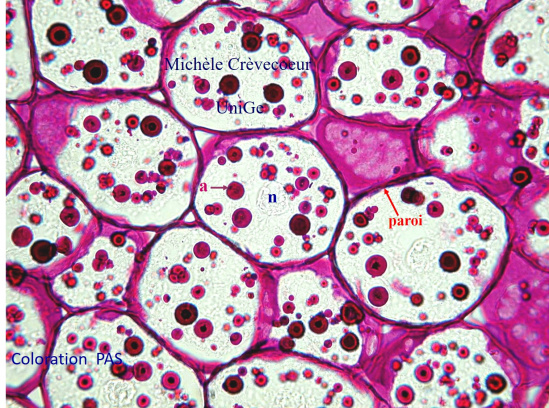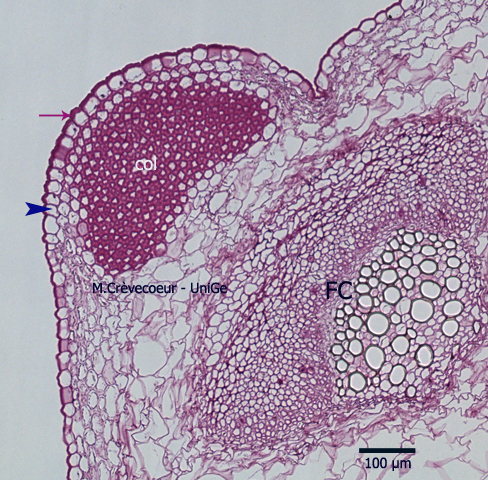Polysaccharide staining of paraffin sections using PAS reaction (Periodic Acid Schiff)
The PAS staining is excellent for localization and identification of carbohydrates on sections. It is specific of different polysaccharides when performed in controlled conditions. The protocol given on this page has been used for staining paraffin sections (8 µm thick) through plant organs. Two micrographs are shown to illustrate the result of the staining.
The different steps for Feulgen reaction on paraffin sections are listed here after
- Deparaffinize and rehydrate to water
- Oxidize in 0,5 % periodic acid solution for 15 min at room temperature. A control section without treatment is immersed in water.
- Wash in tap water for 10 min then in distilled water
- Stain with Schiff’s reagent at darkness and free of oxygen. The time of staining varies according to the tissue and the fixative. For example: 15 min for sections through Zea mays embryos fixed with FAA and using a fresh Schiff’s reagent.
- Sulfurous water to remove excess of unfixed Schiff’s reagent.
- Rince in distilled water.
- Dehydrate, clear in xylene and mount in Eukitt or other appropriate mounting medium.
- Observe under the microscope. The carbohydrates are stained dark pink
Principle of the staining
The oxidative process results in the formation of aldehyde groups through carbon-to-carbon bond cleavage from neighbor’s hydroxyl groups. Aldehydes are revealed by the pink coloration as result of their reaction with the colorless Schiff’s reagent (a mixture of pararosaniline and sodium metabisulfite). PAS is an abbreviation for Periodic – Acid – Schiff. Periodic acid that remains in the section after oxidation may be reduced by a treatment with sodium thiosulfate – potassium iodate. In this case the staining is designated as PARS for Periodic Acid Reducing Schiff.
Carbohydrates that are stained are polymers of insoluble glucose such as glycogen, starch, and cellulose.
Below : Part of a cross section through a Zea mays embryo


The cell walls of the different tissues are all pink stained. The collenchyma staining is more intense as result of the cellulosic thickening of the walls of this support tissue. (col: angular collenchyma). Blue arrow: epidermis with its cuticle (pink arrow).